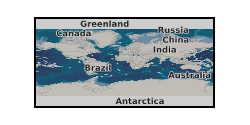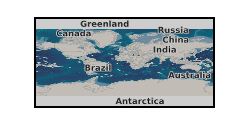Cenozoic
Type of resources
Available actions
Topics
Keywords
Contact for the resource
Provided by
Years
Formats
Representation types
Update frequencies
-

Cretaceous to Recent marine assemblages (total of 24,372) used to measure uplift, interpreted paleo-water depths and measured uplift. This inventory contains information about age, location, stratigraphic origin (i.e., formation, unit, member), lithology, paleoenvironment, and tectonic setting at the time of deposition and references to original source material. An extended methodology is presented in, Victoria M. Fernandes, Gareth G. Roberts; Cretaceous to Recent net continental uplift from paleobiological data: Insights into sub-plate support. GSA Bulletin 2020;; 133 (5-6): 1217–1236. doi: https://doi.org/10.1130/B35739.1 Examples of this information being used to test mantle convection simulations is presented in, Victoria, M. Fernandes, Gareth G. Roberts, Fred Richards; Testing Mantle Convection Simulations With Paleobiology and Other Stratigraphic Observations: Examples From Western North America. G-Cubed 2024; 25(e2023GC011381). doi: https://doi.org/10.1029/2023GC011381
-

3484 Cenozoic fossil fungi records from published data. Files are: MyCeno_records.csv = records of fossil fungi; MyCeno_citations.csv = citations for fossil fungi record sources. (‘Citation_IDs’ are linked to ‘Source_of_record_IDs’ and ‘Supporting_literature_IDs’ in the records table); Myceno_column_info.csv = information about columns in the records table.
-

The file contains the validation data on certified reference material for Nd isotope measurement, the LA-MC-ICP-MS composite Pb isotope ratios and Nd isotope time series for Tropic Seamount, north-east Atlantic Ocean. The dataset spans a deposition history covering the last 75 Ma. The record was obtained by analysis of hydrogenetic ferromanganese crust samples recovered during the 2016 JC142 expedition of the MarineE-Tech project.
-

Seawater carbonate system properties and atmospheric carbon dioxide concentration reconstructions from Eocene planktonic foraminifera using boron isotope analyses.
-

The global carbon cycle - how much carbon is stored in its interconnected reservoirs (ocean, atmosphere, plants and soils on land, sediments in the deep sea) as well as the fluxes between them, is not set in stone. We know from the geological record that the concentration of CO2 in the atmosphere has varied enormously over the last few hundred million years. The chemistry of the oceans also gradually changes with time and the organisms living within it adjust and evolve. As a result, how the carbon cycle 'works', and particularly, how well (or not) atmospheric CO2 (and hence climate) is regulated in the face of disruption, also changes on geological time-scales. This creates challenges to understanding the causes and consequences of past global warming like events and how such events can be related to potential future changes. Sediments slowly accumulating in the deep ocean reflect what goes on around and above them, both chemically and biologically. Of particular interest to us is the mineral calcium carbonate (CaCO3), which can be found in the form of chalk and limestone rocks today. CaCO3 is used by certain marine organisms for constructing shells and skeletons. Hence, the amount of CaCO3 that in buried in sediments tells us something about ancient organisms and ecosystems. In addition, CaCO3 will start dissolving in seawater if the conditions too are acidic or the depth (and thus pressure) too great. How much CaCO3 originally created by organisms at the surface that escapes dissolution in sediments below to be buried and preserved in the geological record can thus tell us something about the chemistry, depth, and when data from many locations is available, the circulation of the ocean in the past. Looking for subtle changes in the composition of ancient mud in the hundreds and hundreds of meters of sediment core recovered from the ocean floor by drill ship would be a little like looking for a needle in a haystack. However, Nature has been kind to us and the transition from white-colored sediments rich in the carbonate shells of dead marine organisms to clays devoid of carbonate is easy to spot. This point represents a fine balance between the amount of shell material being deposited to the sediments and the rate of dissolution of these shells. Hence, this reflects a certain relationship between surface ocean biological processes and deep ocean chemistry and circulation. Any change in these factors will drive sediments rich in CaCO3 or devoid of any trace of carbonate secreting organisms. In this project we will compile the records from many hundreds of different sediment cores that have been recovered since the 1960s. Will identify the 'balance point' in these cores (if one exists) and combine all the confirmation to reconstruct how this balance point has changed in depth and time in the different ocean basins. Because the age of the sediments in some cores extends back to well before the white cliffs of Dover were deposited, we will start our record there. The interpretation of our curve will not be entirely straightforward, because multiple environmental influences all push and pull the balance point in different directions and with different strengths. We will therefore also use a computer model representation of the Earth's climate and oceans, its carbon cycle, ocean chemistry, and the composition of sediments in the deep sea. We will use this model to explore how the different aspects of the global carbon cycle affect the balance point, and by comparing model predictions to our new curve, interpret how the carbon cycling and the sensitivity of atmospheric pCO2 (and hence climate) to being perturbed by massive greenhouse gas release, has changed over the past 150 million years. Hence we will not only be able to answer the question: do we live in a particularly 'lucky' or 'unlucky' time in terms of how sensitive our global environment is burning fossil fuels, but we will know why.
 NERC Data Catalogue Service
NERC Data Catalogue Service